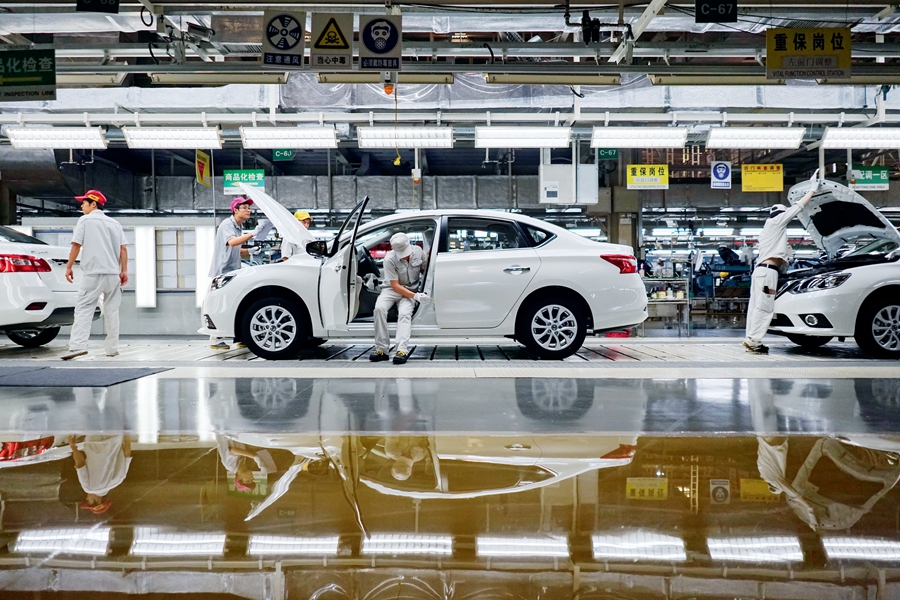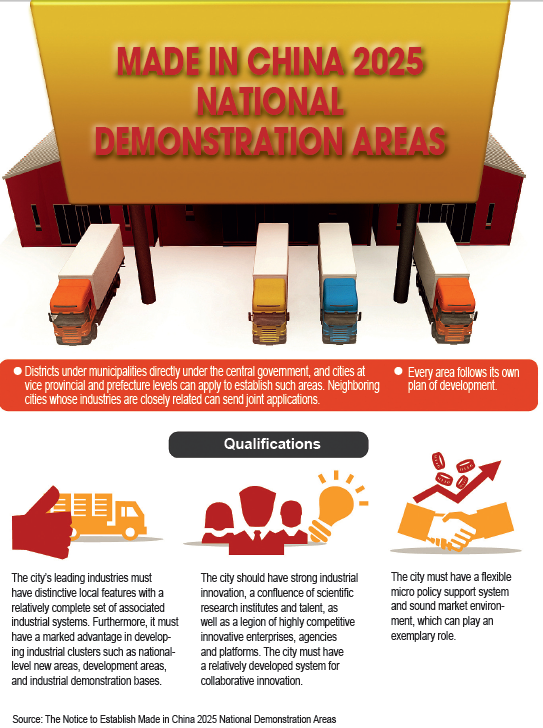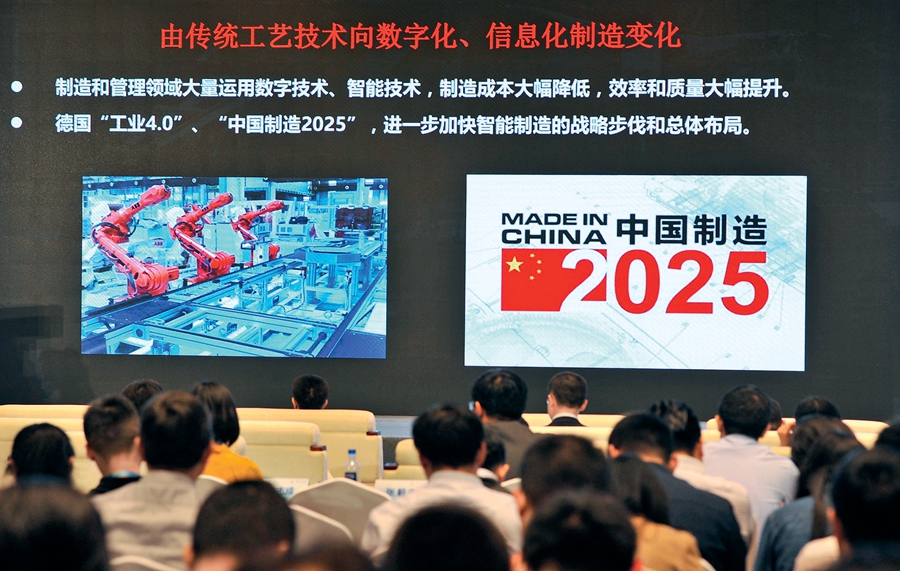By ZHU SENDI
By ZHU SENDI
THE waves of the fourth industrial revolution are pummeling the world’s manufacturing sector with a force unseen before, plunging it into unprecedented adjustments and changes. In response, developed industrialized countries devise national strategies to take the initiative and maintain stability and growth in the forthcoming transformation.

Under the Made in China 2025 plan, China’s auto industry is undergoing a new round of technical upgrading
The U.S., for instance, launched the Advanced Manufacturing Partnership (AMP) in 2011, with the aim of sustaining its leadership in advanced manufacturing. It later vowed to reindustrialize the country and bring back manufacturing jobs. Similarly, Germany made the High-Tech Strategy 2020, the U.K. started the Foresight Project, Japan rolled out plans for the development of the Internet of Things and robotics, France worked out the Industry of the Future initiative, and the Republic of Korea drew a plan to boost the momentum of future growth. They all aim to prepare domestic manufacturers for the future to seek greater development.
China’s manufacturing sector is the world’s largest in size, but lags far behind that of developed industrialized countries in terms of performance, efficiency, quality, industrial structure, energy consumption rate, and sustainable development capacity. It is imperative for China to change course from increasing size and growth rate to improving quality and performance, and shifting from high-speed to high-quality development. Only by doing so will Chinese manufacturing achieve sustainable development, continue to be the centerpiece of the national economy, and secure a position in global manufacturing commensurate with China’s international status.
Direction and Foundation
In 2013, the Chinese Academy of Engineering sponsored a study for more than 100 academicians and experts on the global trend of manufacturing development, relevant strategies and measures in developed industrialized countries, existing problems in Chinese manufacturing, and impacts of major technical advances. Based on this research, the Chinese government released the Made in China 2025 plan in May 2015.
By implementing this plan, China expects to achieve the following goals in 30 years: cut energy consumption, increase productivity, mitigate impacts on the environment, enhance technical innovation capacity, optimize industrial structure, improve production organization, accelerate the integration of informationization and industrialization, and expand international cooperation. With progress in all these aspects, China will transform and upgrade its manufacturing industry, boost its competitiveness, and become a world-leading manufacturer.

To realize these goals, China launched five projects – namely building manufacturing innovation centers, smart manufacturing, green manufacturing, building a robust industrial foundation, and innovations in high-end equipment manufacturing, as well as two campaigns to improve quality and services respectively. It also made development plans for professionals in the manufacturing sectors and development goals for information technology, new materials, and pharmaceutical sectors.
Under the Made in China 2025 plan, the development of Chinese manufacturing will be spearheaded by innovation, based on a strong industrial foundation and good quality, and focus on smart manufacturing, green manufacturing, and service-oriented manufacturing. This roadmap reveals that Chinese manufacturing will tackle its problems head on and make progress on multiple fronts in a systematic manner. The final goal is to upgrade the sector as a whole, and boldly leap forward into the fourth industrial revolution. The Made in China 2025 plan embodies President Xi Jinping’s vision of innovative, coordinated, green, and open development that is for everyone, and is a key move to build up the supply capacity of Chinese manufacturing.
For the success of this plan, we must pay particular attention to the following four issues. First, we must continue to deepen reforms in all areas, ignite the vigor of businesses through institutional innovations, and develop productive forces. Second, we must enable the market to play the decisive role in resource allocation, give better play to the role of government, and create a good business environment to encourage innovation and entrepreneurship. Third, we must further improve our innovation capacity, fueling industrial development with innovation and replacing old growth drivers with new ones. Fourth, we must open wider to the world, and conduct fair and win-win international cooperation, boosting Chinese manufacturing’s international competitiveness and meanwhile contributing to the evolution of global manufacturing.
According to the Made in China 2025 plan, China will make the market play the dominant role in an open environment, and galvanize the vigor and ardor of manufacturers. It will also better protect intellectual property rights through broad domestic and international cooperation, and increase the innovation and supply capacities of its manufacturing sector.
Smart and Green Production on the Rise
Implemented for three years, the Made in China 2025 plan has delivered early results. The awareness of the importance of manufacturing to national economy has increased in every sector and every part of China, and encouraging progress has been made in smart and green production. What’s more, innovative ability has been improved, industrial transformation and upgrading and shifts in growth drivers have been accelerated, leading to notable increase in the innovation and supply capacities of certain industries.

On April 23, 2018, at the first Digital China Summit, many speakers talk about Made in China 2025.
Since 2012 China has moved up on major indices of manufacturing strength. They include the number of international patents per unit added value of manufacturing, R&D investment, the share of researchers among people employed by manufacturing, labor productivity, sales margin, and the ICT (information and communication technologies) Development Index. In 2015, China’s intensity of R&D input for manufacturing reached 2.01 percent, for the first time exceeding two percent in five years.
The enterprises enlisted in the trial smart production program have increased their production efficiency by 20 percent, and lowered operational costs, production development cycles, defective product rates, and energy consumption by 20 percent, 30 percent, 20 percent and 10 percent respectively. They have come to the forefront of the fourth industrial revolution, and offered inspiration for their peers still at the previous stages.
Businesses of all ownerships in China – state-owned, private or foreign-funded – have participated in the Made in China 2025 plan, and benefited from it. Many foreign companies operating in China have seen marked growth in their automation business, and foreign brands of equipment for smart manufacturing have expanded presence in the Chinese market. Take the example of industrial robots: in 2016, 42,963 multi-joint robots and 9,553 SCARA robots were sold in China, marking a year-on-year increase of 25.2 percent and 51.9 percent respectively. Their respective shares in the Chinese market stood at 78.5 percent and 88.7 percent.
A Tough Road Ahead
To be honest, Chinese manufacturing as a whole has not weaned itself from the old model of size-dependent growth, and the transition from quantity increase to quality improvement is not smooth. Compared with the world’s leading manufacturing countries, such as the U.S., Germany and Japan, China still needs to do a lot to improve in terms of quality and efficiency, structural optimization and sustainable development. In light of this, China’s manufacturing sector should focus on improving its quality and efficiency in the coming years.
The implementation of Made in China 2025 plan has yielded tangible results, thanks to strenuous efforts by Chinese manufacturers with the support of all parties concerned. Its success is the outcome of embracing the fourth industrial revolution and new technologies, innovation over a long period of time, as well as win-win cooperation on equal footing between Chinese and international companies in an open environment.
The plan sets the direction and goals of the development of Chinese manufacturing, and provides more opportunities for exchanges and cooperation between manufacturers worldwide that will lead to progress for all. Chinese manufacturers have carried out extensive and diversified contacts with their counterparts in Germany, Japan, the U.S. and U.K. over past years. Programs under the Made in China 2025 plan and the campaign to transform and upgrade Chinese manufacturing have offered and will continue to offer business opportunities and market for foreign manufacturers. As the implementation of the Made in China 2025 plan proceeds, China’s exchanges and cooperation with advanced manufacturing countries are expected to become more vibrant and fruitful, allowing them to learn from each other and reap mutual benefits in the process.
Certain foreign organizations made biased conjectures about the Made in China 2025 plan, employing flawed logic, unjustified reasoning, and double standards. The findings report of the Section 301 investigation by the United States Trade Representative (USTR) includes a large segment on the plan, but makes inferences about it that is contrary to the facts. Based on the report, the U.S. proposed 25 percent tariffs on 1,300 Chinese goods, including those of aviation, space, communications, and machinery. Though this move will affect the concerned products’ competitiveness on the U.S. market, and inflict financial damage on their producers, China’s countermeasures will also deliver a blow to certain American industries.
The Made in China 2025 plan will sharpen Chinese manufacturing’s international competitive edge. By embracing the opportunities and challenges brought about by the fourth industrial revolution and capitalizing on technical advances made in the course, Chinese manufacturing will accelerate its transformation and shift to new growth drivers, further enhance its innovative and supply capacities, and march steadfastly towards China’s goal of becoming a leading manufacturing country in spite of all hurdles.
ZHU SENDI is honorary director of the expert panel of China Machinery Industry Federation.